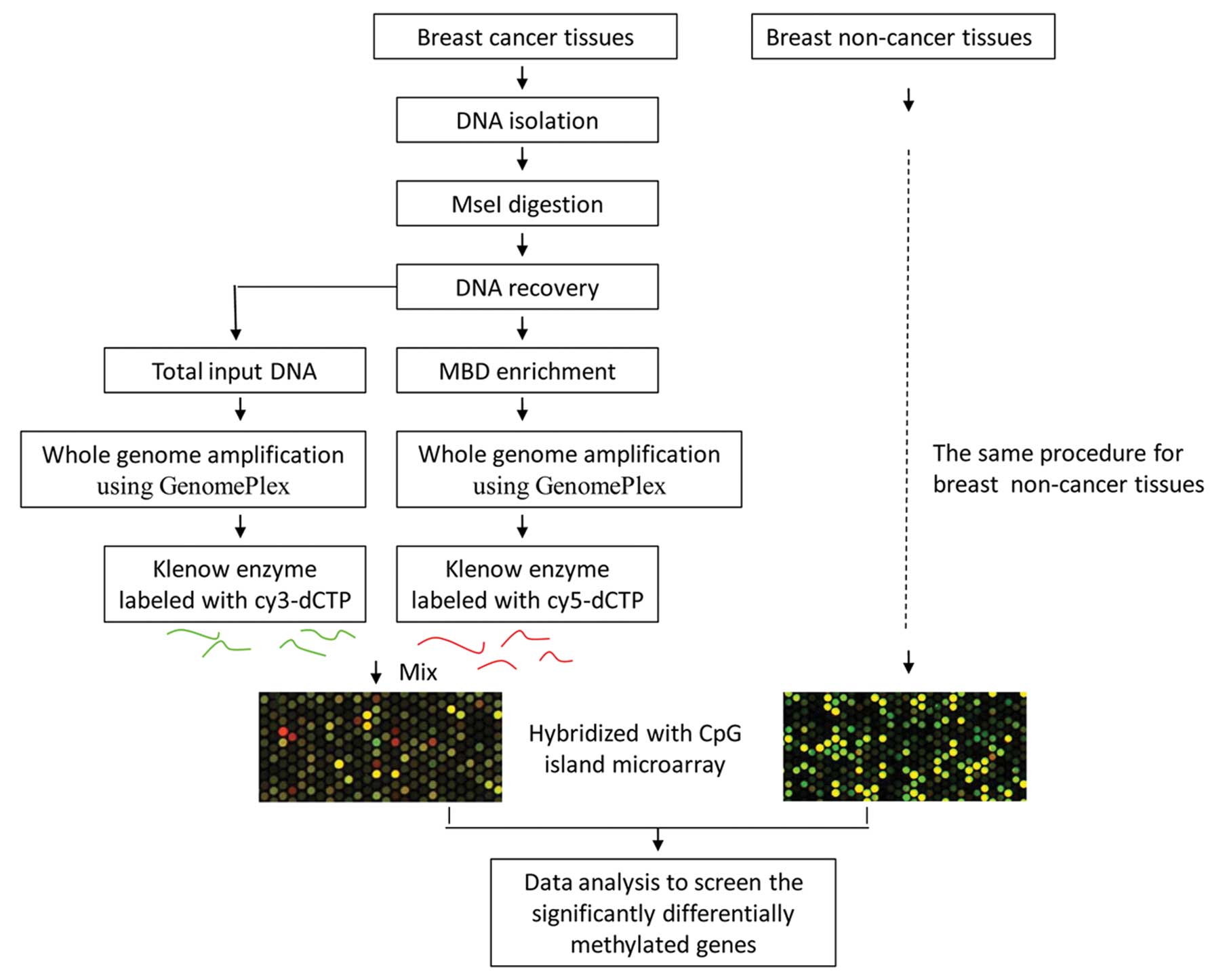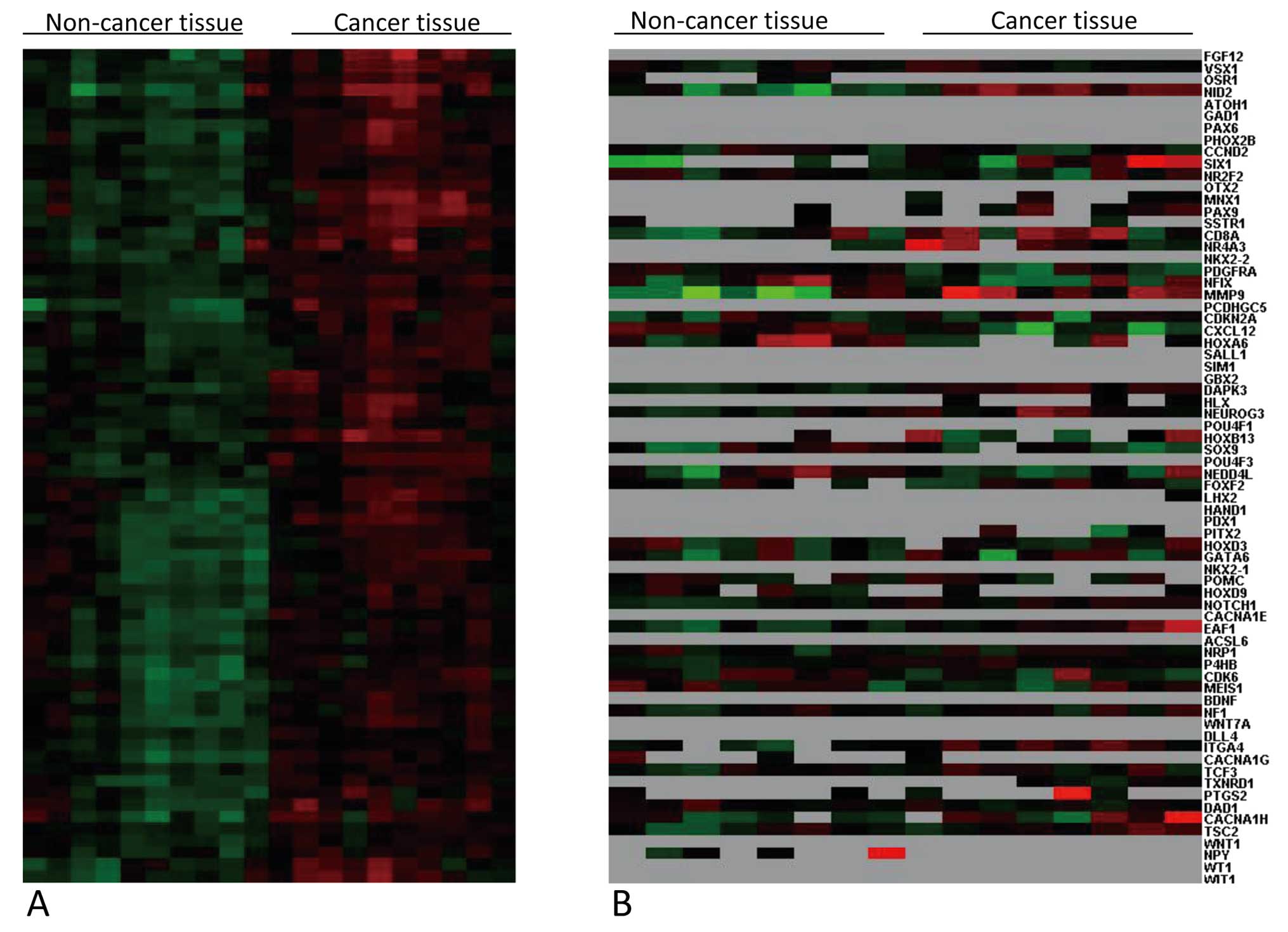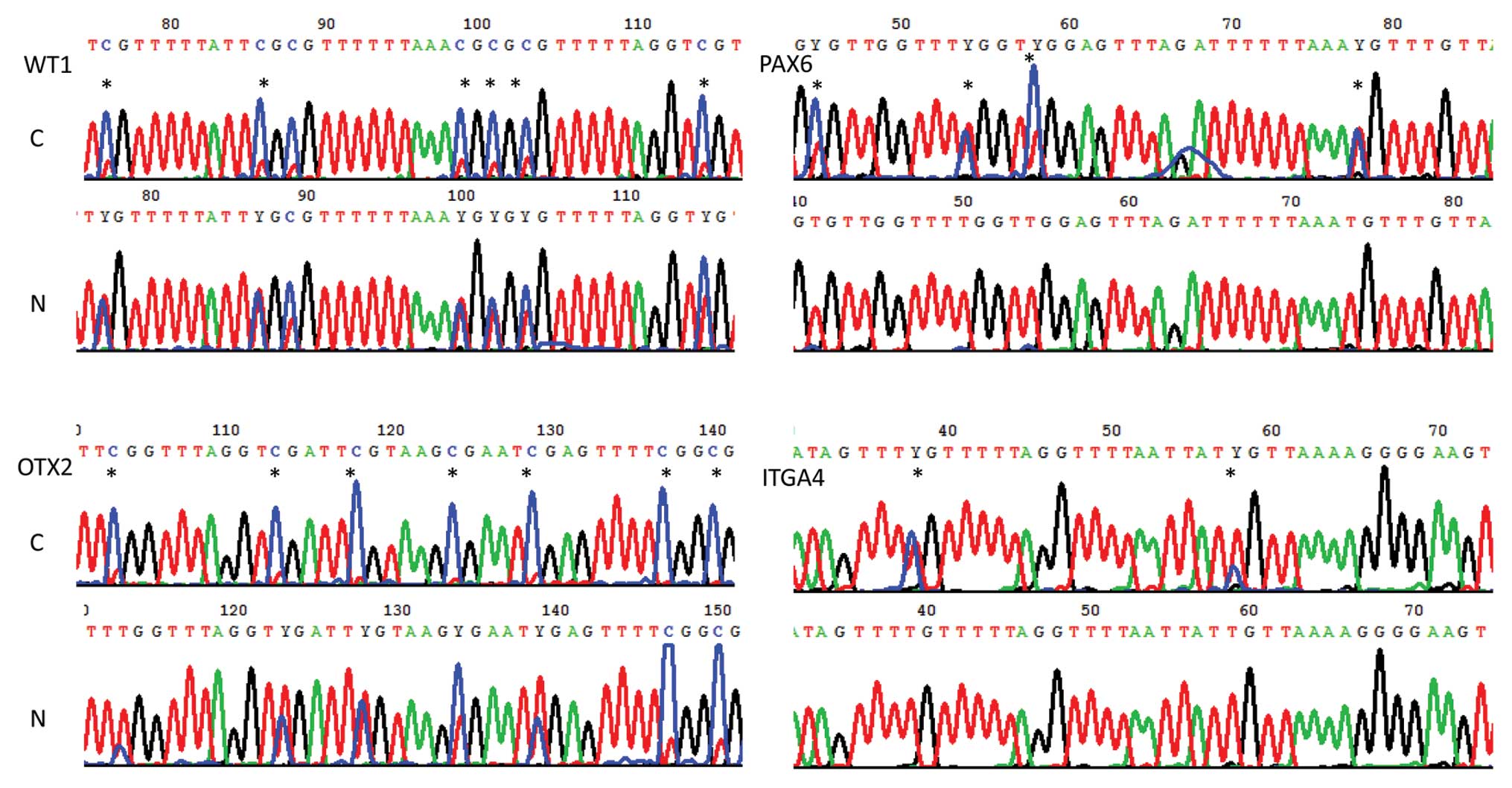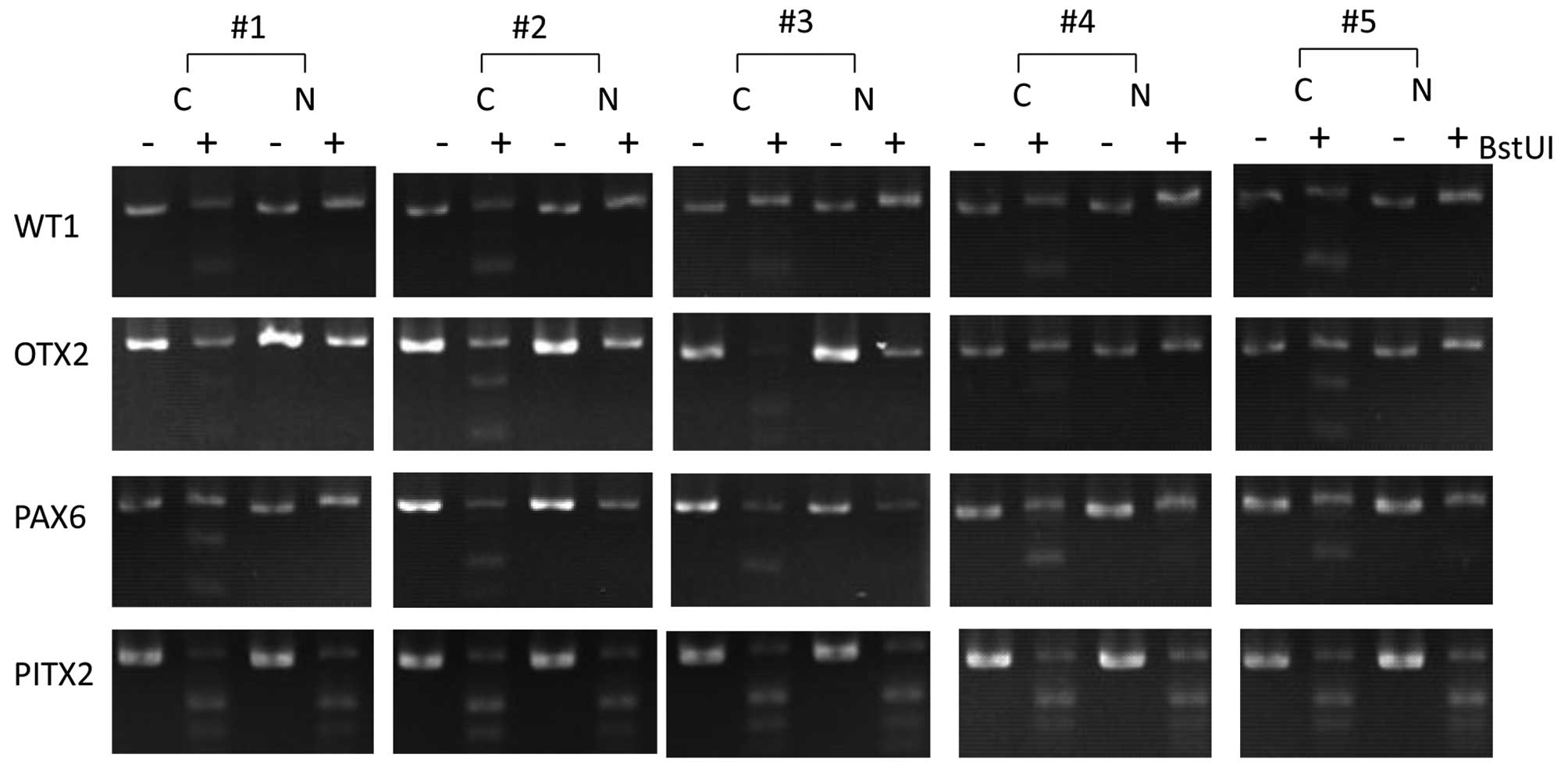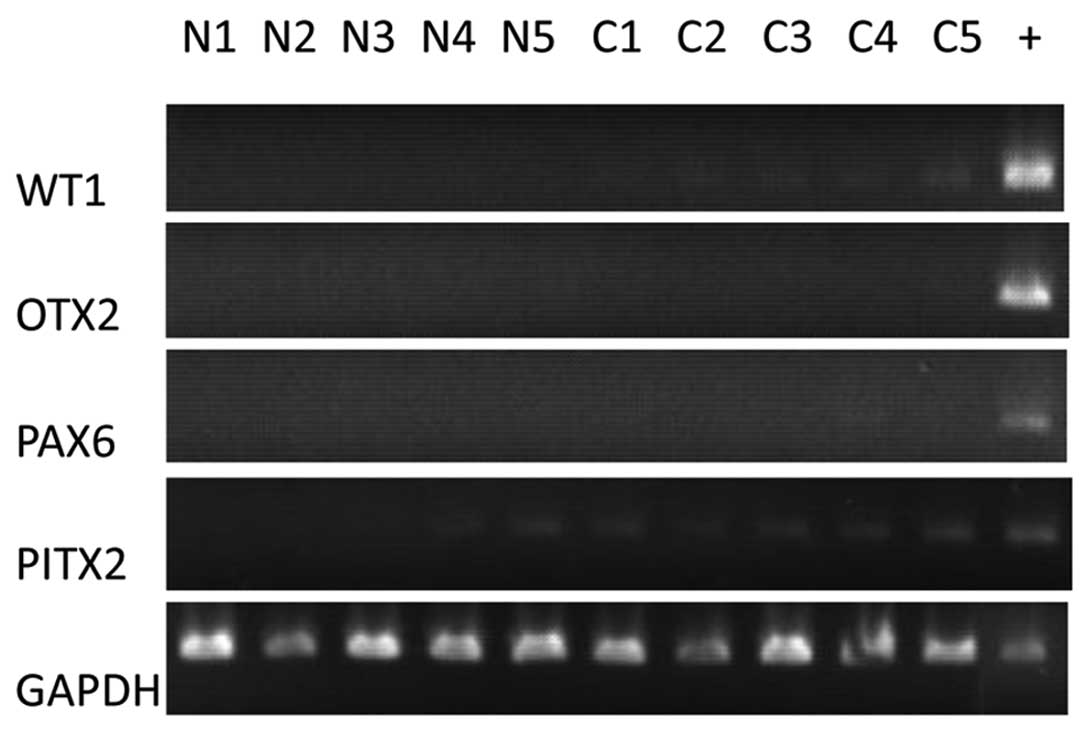|
1
|
Ferlay J, Shin HR, Bray F, Forman D,
Mathers C and Parkin DM: Estimates of worldwide burden of cancer in
2008: GLOBOCAN 2008. Int J Cancer. 127:2893–2917. 2010. View Article : Google Scholar : PubMed/NCBI
|
|
2
|
Esteller M: Epigenetics in cancer. N Engl
J Med. 358:1148–1159. 2008. View Article : Google Scholar
|
|
3
|
Martens JW, Margossian AL, Schmitt M,
Foekens J and Harbeck N: DNA methylation as a biomarker in breast
cancer. Future Oncol. 5:1245–1256. 2009. View Article : Google Scholar : PubMed/NCBI
|
|
4
|
Jovanovic J, Ronneberg JA, Tost J and
Kristensen V: The epigenetics of breast cancer. Mol Oncol.
4:242–254. 2010. View Article : Google Scholar : PubMed/NCBI
|
|
5
|
Brooks J, Cairns P and Zeleniuch-Jacquotte
A: Promoter methylation and the detection of breast cancer. Cancer
Causes Control. 20:1539–1550. 2009. View Article : Google Scholar : PubMed/NCBI
|
|
6
|
Sproul D, Nestor C, Culley J, et al:
Transcriptionally repressed genes become aberrantly methylated and
distinguish tumors of different lineages in breast cancer. Proc
Natl Acad Sci USA. 108:4364–4369. 2011. View Article : Google Scholar
|
|
7
|
Ngan CY, Yamamoto H, Seshimo I, et al:
Quantitative evaluation of vimentin expression in tumour stroma of
colorectal cancer. Br J Cancer. 96:986–992. 2007. View Article : Google Scholar : PubMed/NCBI
|
|
8
|
Chen WD, Han ZJ, Skoletsky J, et al:
Detection in fecal DNA of colon cancer-specific methylation of the
nonexpressed vimentin gene. J Natl Cancer Inst. 97:1124–1132. 2005.
View Article : Google Scholar : PubMed/NCBI
|
|
9
|
Ruike Y, Imanaka Y, Sato F, Shimizu K and
Tsujimoto G: Genome-wide analysis of aberrant methylation in human
breast cancer cells using methyl-DNA immunoprecipitation combined
with high-throughput sequencing. BMC Genomics. 11:1372010.
View Article : Google Scholar
|
|
10
|
Wu X, Rauch TA, Zhong X, et al: CpG island
hypermethylation in human astrocytomas. Cancer Res. 70:2718–2727.
2010. View Article : Google Scholar : PubMed/NCBI
|
|
11
|
Tommasi S, Karm DL, Wu X, Yen Y and
Pfeifer GP: Methylation of homeobox genes is a frequent and early
epigenetic event in breast cancer. Breast Cancer Res. 11:R142009.
View Article : Google Scholar : PubMed/NCBI
|
|
12
|
Rauch TA and Pfeifer GP: The MIRA method
for DNA methylation analysis. Methods Mol Biol. 507:65–75. 2009.
View Article : Google Scholar : PubMed/NCBI
|
|
13
|
Richards AA, Santos LJ, Nichols HA, et al:
Cryptic chromosomal abnormalities identified in children with
congenital heart disease. Pediatr Res. 64:358–363. 2008. View Article : Google Scholar : PubMed/NCBI
|
|
14
|
Leung TY, Vogel I, Lau TK, et al:
Identification of submicroscopic chromosomal aberrations in fetuses
with increased nuchal translucency and apparently normal karyotype.
Ultrasound Obstet Gynecol. 38:314–319. 2011. View Article : Google Scholar : PubMed/NCBI
|
|
15
|
Xiong Z and Laird PW: COBRA: a sensitive
and quantitative DNA methylation assay. Nucleic Acids Res.
25:2532–2534. 1997. View Article : Google Scholar : PubMed/NCBI
|
|
16
|
Ibanez de Caceres I, Cortes-Sempere M,
Moratilla C, et al: IGFBP-3 hypermethylation-derived deficiency
mediates cisplatin resistance in non-small-cell lung cancer.
Oncogene. 29:1681–1690. 2010.PubMed/NCBI
|
|
17
|
Rauch T, Wang Z, Zhang X, et al: Homeobox
gene methylation in lung cancer studied by genome-wide analysis
with a microarray-based methylated CpG island recovery assay. Proc
Natl Acad Sci USA. 104:5527–5532. 2007. View Article : Google Scholar : PubMed/NCBI
|
|
18
|
Maier S, Nimmrich I, Koenig T, et al:
DNA-methylation of the homeodomain transcription factor PITX2
reliably predicts risk of distant disease recurrence in
tamoxifen-treated, node-negative breast cancer patients – Technical
and clinical validation in a multi-centre setting in collaboration
with the European Organisation for Research and Treatment of Cancer
(EORTC) PathoBiology group. Eur J Cancer. 43:1679–1686.
2007.PubMed/NCBI
|
|
19
|
Harbeck N, Nimmrich I, Hartmann A, et al:
Multicenter study using paraffin-embedded tumor tissue testing
PITX2 DNA methylation as a marker for outcome prediction in
tamoxifen-treated, node-negative breast cancer patients. J Clin
Oncol. 26:5036–5042. 2008. View Article : Google Scholar
|
|
20
|
Loeb DM, Evron E, Patel CB, et al: Wilms’
tumor suppressor gene (WT1) is expressed in primary breast tumors
despite tumor-specific promoter methylation. Cancer Res.
61:921–925. 2001.
|
|
21
|
Yang JL, Klinkebiel D, Boland MJ, Tang L
and Christman JK: [Promoter methylation and mRNA expression of WT1
gene in MCF10 breast cancer model]. Zhonghua Bing Li Xue Za Zhi.
36:253–258. 2007.(In Chinese).
|
|
22
|
Silberstein GB, Van Horn K, Strickland P,
Roberts CT Jr and Daniel CW: Altered expression of the WT1 Wilms
tumor suppressor gene in human breast cancer. Proc Natl Acad Sci
USA. 94:8132–8137. 1997. View Article : Google Scholar : PubMed/NCBI
|
|
23
|
Laux DE, Curran EM, Welshons WV, Lubahn DB
and Huang TH: Hypermethylation of the Wilms’ tumor suppressor gene
CpG island in human breast carcinomas. Breast Cancer Res Treat.
56:35–43. 1999.
|
|
24
|
Brenet F, Moh M, Funk P, et al: DNA
methylation of the first exon is tightly linked to transcriptional
silencing. PLoS One. 6:e145242011. View Article : Google Scholar : PubMed/NCBI
|















